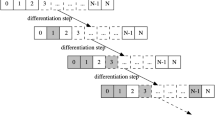Abstract
Boolean networks are currently acknowledged as a powerful model for cell dynamics phenomena. Recently, the possibility of modelling methylation mechanisms—involved in cell differentiation—in Random Boolean Networks have been discussed: methylated genes are represented in the network as nodes locked to value 0 (frozen nodes). Preliminary results show that this mechanism can reproduce dynamics with characteristics in agreement with those of cell undergoing differentiation. In a second, parallel work, the effect of nodes with self-loops in Random Boolean Networks has been studied, showing that the average number of attractors may increase with the number of self-loops, whilst the average attractor robustness tends to decrease. As these two studies are aimed at extending the applicability of Random Boolean Networks to model cell differentiation phenomena, in this work we study the combined effect of the previous two approaches. Results in simulation show that frozen nodes tend to partially dampen the effects of self-loops on attractor number and robustness. This outcome suggests that both the variants can indeed be effectively combined in Boolean models for cell differentiation.
Access this chapter
Tax calculation will be finalised at checkout
Purchases are for personal use only
Similar content being viewed by others
Notes
- 1.
Condensed structure in which the DNA of eukaryotic cells is organised.
- 2.
This happens in particular when the self-regulation is modelled by a canalizing function, such as the logical OR.
- 3.
The same, of course, happens with the AND function and value 0.
References
Aldana, M., Coppersmith, S., Kadanoff, L.P.: Boolean dynamics with random couplings. In: Kaplan, E., Marsden, J.E., Sreenivasan, K.R. (eds.) Perspectives and Problems in Nolinear Science, pp. 23–89. Springer, New York (2003). https://doi.org/10.1007/978-0-387-21789-5_2
Bastolla, U., Parisi, G.: The modular structure of kauffman networks. Physica D: Nonlinear Phenom. 115(3–4), 219–233 (1998)
Bastolla, U., Parisi, G.: Relevant elements, magnetization and dynamical properties in kauffman networks: a numerical study. Physica D 115(3–4), 203–218 (1998)
Bornholdt, S.: Boolean network models of cellular regulation: prospects and limitations. J. R. Soc. Interface 5(Suppl. 1), S85–S94 (2008)
Braccini, M., Montagna, S., Roli, A.: Self-loops favour diversification and asymmetric transitions between attractors in boolean network models. In: Cagnoni, S., Mordonini, M., Pecori, R., Roli, A., Villani, M. (eds.) WIVACE 2018. CCIS, vol. 900, pp. 30–41. Springer, Cham (2019). https://doi.org/10.1007/978-3-030-21733-4_3
Braccini, M., Roli, A., Villani, M., Montagna, S., Serra, R.: A simplified model of chromatin dynamics drives differentiation process in Boolean models of GRN. In: The 2019 Conference on Artificial Life (ALIFE) (2019)
Gilbert, S.F., Barresi, M.J.F.: Developmental biology, chap. 3, XI edn., pp. 50–52. Sinauer Associates Inc. (2016)
Helikar, T., Kowal, B., McClenathan, S., Bruckner, M., Rowley, T., Madrahimov, A., Wicks, B., Shrestha, M., Limbu, K., Rogers, J.A.: The cell collective: toward an open and collaborative approach to systems biology. BMC Syst. Biol. 6(1), 96 (2012)
Kauffman, S.A.: Metabolic stability and epigenesis in randomly constructed genetic nets. J. Theoret. Biol. 22(3), 437–467 (1969)
Kauffman, S.A.: The Origins of Order. Oxford University Press, Oxford (1993)
Kauffman, S.A.: Investigations. Oxford University Press, Oxford (2000)
Kauffman, S.A.: A proposal for using the ensemble approach to understand genetic regulatory networks. J. Theoret. Biol. 230(4), 581–590 (2004)
Kim, M., Costello, J.: Dna methylation: an epigenetic mark of cellular memory. Exp. Mol. Med. 49(4), e322 (2017)
Montagna, S., Braccini, M., Roli, A.: The impact of self-loops on Boolean networks attractor landscape and implications for cell differentiation modelling. In: IEEE/ACM Trans. Computat. Biol. Bioinform. https://doi.org/10.1109/TCBB.2020.2968310. (Early access)
Montagna, S., Braccini, M., Roli, A.: The impact of self-loops in random boolean network dynamics: a simulation analysis. In: Pelillo, M., Poli, I., Roli, A., Serra, R., Slanzi, D., Villani, M. (eds.) WIVACE 2017. CCIS, vol. 830, pp. 104–115. Springer, Cham (2018). https://doi.org/10.1007/978-3-319-78658-2_8
Perino, M., Veenstra, G.: Chromatin control of developmental dynamics and plasticity. Dev. Cell 38(6), 610–620 (2016)
Schuettengruber, B., Cavalli, G.: Recruitment of polycomb group complexes and their role in the dynamic regulation of cell fate choice. Development 136(21), 3531–3542 (2009)
Author information
Authors and Affiliations
Corresponding author
Editor information
Editors and Affiliations
Rights and permissions
Copyright information
© 2020 Springer Nature Switzerland AG
About this paper
Cite this paper
Braccini, M., Roli, A., Villani, M., Montagna, S., Serra, R. (2020). The Effects of a Simplified Model of Chromatin Dynamics on Attractors Robustness in Random Boolean Networks with Self-loops: An Experimental Study. In: Cicirelli, F., Guerrieri, A., Pizzuti, C., Socievole, A., Spezzano, G., Vinci, A. (eds) Artificial Life and Evolutionary Computation. WIVACE 2019. Communications in Computer and Information Science, vol 1200. Springer, Cham. https://doi.org/10.1007/978-3-030-45016-8_4
Download citation
DOI: https://doi.org/10.1007/978-3-030-45016-8_4
Published:
Publisher Name: Springer, Cham
Print ISBN: 978-3-030-45015-1
Online ISBN: 978-3-030-45016-8
eBook Packages: Computer ScienceComputer Science (R0)




